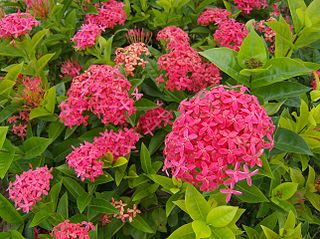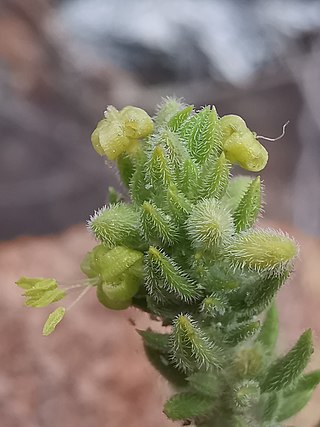
Colleters are plant structures, multicellular secretory hairs, found in groups near the base of petioles, on stipules, and on sepals. They are found in members of the Loganiaceae and Rubiaceae families. [1] [2]

Colleters are plant structures, multicellular secretory hairs, found in groups near the base of petioles, on stipules, and on sepals. They are found in members of the Loganiaceae and Rubiaceae families. [1] [2]

The Rubiaceae are a family of flowering plants, commonly known as the coffee, madder, or bedstraw family. It consists of terrestrial trees, shrubs, lianas, or herbs that are recognizable by simple, opposite leaves with interpetiolar stipules and sympetalous actinomorphic flowers. The family contains about 13,500 species in about 620 genera, which makes it the fourth-largest angiosperm family. Rubiaceae has a cosmopolitan distribution; however, the largest species diversity is concentrated in the tropics and subtropics. Economically important genera include Coffea, the source of coffee, Cinchona, the source of the antimalarial alkaloid quinine, ornamental cultivars, and historically some dye plants.

Uncaria is a genus of flowering plants in the family Rubiaceae. It has about 40 species. Their distribution is pantropical, with most species native to tropical Asia, three from Africa and the Mediterranean and two from the neotropics. They are known colloquially as gambier, cat's claw or uña de gato. The latter two names are shared with several other plants. The type species for the genus is Uncaria guianensis.

Gentianales is an order of flowering plants, included within the asterid clade of eudicots. It comprises more than 20,000 species in about 1,200 genera in 5 families. More than 80% of the species in this order belong to the family Rubiaceae.

Genipa is a genus of trees in the family Rubiaceae. This genus is native to the American tropical forests.

Rubia is the type genus of the Rubiaceae family of flowering plants, which also contains coffee. It contains around 80 species of perennial scrambling or climbing herbs and subshrubs native to the Old World. The genus and its best-known species are commonly known as madder, e.g. Rubia tinctorum, Rubia peregrina, and Rubia cordifolia.

Sherardia is a monotypic genus of flowering plants in the family Rubiaceae. The genus contains only one species, Sherardia arvensis, the (blue) field madder, which is widespread across most of Europe and northern Africa as well as southwest and central Asia and Macaronesia. It is also reportedly naturalized in Australia, New Zealand, Taiwan, Kerguelen, Ethiopia, Sudan, southern Africa, Mexico, Costa Rica, South America, Bermuda, Cuba, Haiti and much of Canada and the United States.

Bouvardia is a genus of flowering plants in the family Rubiaceae. It contains about 50 species of evergreen herbs and shrubs native to Mexico and Central America, with one species extending into the southwestern United States. The genus is named in honor of Charles Bouvard (1572–1658), physician to Louis XIII, and superintendent of the Jardin du Roi in Paris.
Vedic metre refers to the poetic metre in the Vedic literature. The study of Vedic metre, along with post-Vedic metre, is part of Chandas, one of the six Vedanga disciplines.
Blepharidium is a monotypic genus of flowering plants in the family Rubiaceae. The genus contains only one species, viz. Blepharidium guatemalense, which is native to Guatemala, Honduras and southern Mexico. Older works might mention two species.

Guettarda is a plant genus in the family Rubiaceae. Most of these plants are known by the common name velvetseed.
Keetia is a genus of flowering plants in the family Rubiaceae. It consists of climbers or scrambling shrubs, rarely small trees.

Alibertia patinoi, commonly known as borojó, is a small (2-5m), dioecious tropical rainforest tree, one of the few edible fruit bearing species in the Rubiaceae family. Borojó, native to the world's wettest lowlands, grows in the Chocó Department of northwestern Colombia and in the Esmeraldas Province of northwestern Ecuador.

Fruit anatomy is the plant anatomy of the internal structure of fruit. Fruits are the mature ovary or ovaries of one or more flowers. They are found in three main anatomical categories: aggregate fruits, multiple fruits, and simple fruits.

Vanguerieae is a tribe of flowering plants in the family Rubiaceae and contains about 655 species in 30 genera. It is one of the most species-rich groups within the family and it is distributed across the Paleotropics.

Geophila is a genus of herbs in the family Rubiaceae. This genus is pantropical, as it is found in most tropical regions.

Ixoroideae is a subfamily of flowering plants in the family Rubiaceae and contains about 4000 species in 27 tribes.
Dialypetalanthus is a genus of trees in the family Rubiaceae. It only contains one species, Dialypetalanthus fuscescens, which is found in Bolivia, Brazil and Peru.

Gardenieae is a tribe of flowering plants in the family Rubiaceae and contains about 586 species in 53 genera.

Anthospermeae is a tribe of flowering plants in the family Rubiaceae and contains 208 species in 12 genera. Its representatives are found in the Southern Hemisphere, with the exception of the two species of the genus Phyllis. At least two genera, namely Coprosma and Galopina are anemophilous.

Coffea racemosa, also known as racemosa coffee and Inhambane coffee, is a species of flowering plant in the family Rubiaceae. It has naturally low levels of caffeine, less than half of that found in Coffea arabica, and a quarter of that in Robusta coffee. It is endemic to the coastal forest belt between northern KwaZulu-Natal in South Africa and Zimbabwe, found in an area less than 150 km2 (58 sq mi) in size. It was widely cultivated by the Portuguese during the 1960-1970s in Mozambique; currently there are only two plantations, at Ibo Island and in Hluhluwe, which remain.